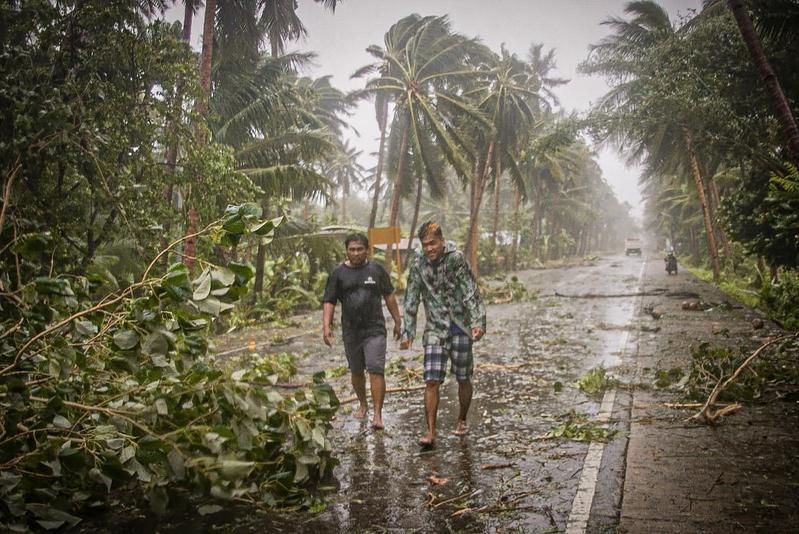 Residents brave rains and strong wind as they walk past uprooted trees along a highway in Can-avid town, Eastern Samar province, central Philippines on May 14, 2020, as Typhoon Vongfong makes landfall. A powerful typhoon hit the central Philippines on May 14, forcing a complicated and risky evacuation for tens of thousands already hunkered down at home during the coronavirus pandemic. Because of the twin threat of the storm and the virus, evacuation centres in the central Philippines will only accept half their capacity and evacuees will have to wear facemasks. (ALREN BERONIO / AFP)
Residents brave rains and strong wind as they walk past uprooted trees along a highway in Can-avid town, Eastern Samar province, central Philippines on May 14, 2020, as Typhoon Vongfong makes landfall. A powerful typhoon hit the central Philippines on May 14, forcing a complicated and risky evacuation for tens of thousands already hunkered down at home during the coronavirus pandemic. Because of the twin threat of the storm and the virus, evacuation centres in the central Philippines will only accept half their capacity and evacuees will have to wear facemasks. (ALREN BERONIO / AFP)
MANILA - Philippine authorities started moving 200,000 people away from their homes in coastal and mountainous areas because of fears of flooding and landslides as a typhoon made landfall on Thursday, disaster officials said.
Vongfong is the first typhoon to batter the Philippines this year as the country grapples with the fallout of COVID-19 pandemic
Typhoon Vongfong tore off roofs and shook trees as it made landfall in central Philippines' Eastern Samar province at 12:15 pm local time on Thursday, said authorities.
Vongfong is the first typhoon to batter the Philippines this year as the country grapples with the fallout of COVID-19 pandemic.
The typhoon unleashed winds of 155 km per hour with a gust of up to 190 km per hour, the Philippine Atmospheric, Geophysical and Astronomical Services Administration said in its bulletin at 2:00 pm local time.
"The eyewall of (the) typhoon Vongfong is bringing violent winds and heavy to intense rains over the northern portion of Eastern Samar. The northern portion of Samar province and the southern portion of Northern Samar will be affected by the eyewall in the coming hours," the state weather bureau warned.
According to the bureau, Vongfong will dump "heavy to intense rains" later on Thursday over Samar provinces, and the provinces of Masbate, Sorsogon, and Catanduanes in the Bicol region in the main island of Luzon.
The bureau further warned of possible flooding and rain-induced landslides in highly to very highly susceptible areas during a heavy or prolonged rainfall.
ALSO READ: Christmas typhoon leaves 28 dead, 12 missing in Philippines
Moreover, the bureau warned the residents of coastal towns of a possible storm surge of up to four meters high within 24 hours.
"Along with large swells, this storm surge may cause potentially life-threatening coastal inundation," the bureau further warned, adding that "sea travel is risky for all types of seacrafts."
The Philippine National Police (PNP) said it will continue strictly enforce quarantine guidelines in the typhoon-affected areas as the country is now under quarantine to stem the spread of the virus.
"(The PNP) will remain resolute and ready for disaster preparedness and response operations to protect lives and properties from the typhoon as it continues to defend our citizens from COVID-19," PNP Spokesperson Bernard Banac said in a statement.
There were no reports of damage or injuries caused by the typhoon so far.
More than 20 typhoons and tropical storms batter the Philippines each year. Aside from typhoons, the archipelago has frequent earthquakes and volcanic eruptions.
READ MORE: Philippine typhoon ruins Christmas for travellers, evacuees
The Philippines is one of the most disaster-prone countries in the world mainly due to its location in the Pacific Ring of Fire and Pacific typhoon belt. Landslides and flash floods are common across the country during the rainy season, especially when typhoon hits.
With Reuters inputs


